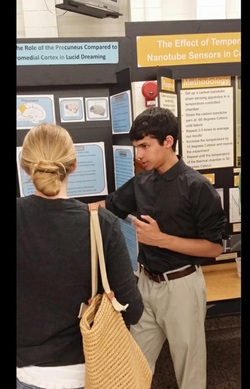Justin D'Souza '16

Title: Investigating the role of the Ventromedial Cortex and Precuneus in Lucid Dreaming
Problem: How do the cortices of the risk taking ventromedial cortex and the cognitive function precuneus relate to one another during lucid dreaming? In addition to examining how the strengths of these cortices correlate, we will also be looking at how the confabulations, or false memories, of lucid dreamers differ from those of non-lucid dreamers.
Activities & Interests: Physics, U.S and Global History, and of course video games!
Abstract: previous literature suggests that Lucid Dreams (LD) may be tied three cortices in the
brain: the dorsolateral prefrontal (DLPFC), ventromedial (vmPFC), and Precuneus. While
studies have examined the relationship between the DLPFC and vmPFC, at present the
relationship between these prefrontal cortices and the Precuneus is largely unknown.
Additionally, it is hypothesized that lucid dreamers experience a higher frequency of
confabulations, or distorted memories, schizotypal traits, and delusions. To examine these
possible connections, we conducted a study in 13 high school students. Participants completed
different dream questionnaires, sleep assessments, and personality scales. Additionally, four
computer tasks were given, the Wisconsin Card Sort Task (WCST), Iowa Gambling Task (IGT),
Recognition Memory Task, and Serial Reaction Time Task. Following these tasks, participants
kept a dream journal for one week, followed by a second set of the same tasks. Statistical
analysis of lucidity level before and after shows strong correlations between LDs, delusions, and
schizotypal traits, as well as increased performance on the IGT (Ventromedial stimulating) task,
while the WCST data returned no statistically significant correlations. Therefore, lucid dreaming
can be connected with the vmPFC over the DLPFC as well as delusional ideation in a normal
population.
Problem: How do the cortices of the risk taking ventromedial cortex and the cognitive function precuneus relate to one another during lucid dreaming? In addition to examining how the strengths of these cortices correlate, we will also be looking at how the confabulations, or false memories, of lucid dreamers differ from those of non-lucid dreamers.
Activities & Interests: Physics, U.S and Global History, and of course video games!
Abstract: previous literature suggests that Lucid Dreams (LD) may be tied three cortices in the
brain: the dorsolateral prefrontal (DLPFC), ventromedial (vmPFC), and Precuneus. While
studies have examined the relationship between the DLPFC and vmPFC, at present the
relationship between these prefrontal cortices and the Precuneus is largely unknown.
Additionally, it is hypothesized that lucid dreamers experience a higher frequency of
confabulations, or distorted memories, schizotypal traits, and delusions. To examine these
possible connections, we conducted a study in 13 high school students. Participants completed
different dream questionnaires, sleep assessments, and personality scales. Additionally, four
computer tasks were given, the Wisconsin Card Sort Task (WCST), Iowa Gambling Task (IGT),
Recognition Memory Task, and Serial Reaction Time Task. Following these tasks, participants
kept a dream journal for one week, followed by a second set of the same tasks. Statistical
analysis of lucidity level before and after shows strong correlations between LDs, delusions, and
schizotypal traits, as well as increased performance on the IGT (Ventromedial stimulating) task,
while the WCST data returned no statistically significant correlations. Therefore, lucid dreaming
can be connected with the vmPFC over the DLPFC as well as delusional ideation in a normal
population.


